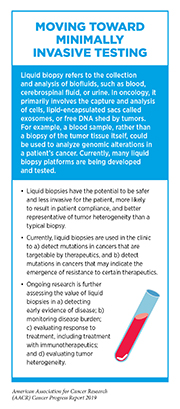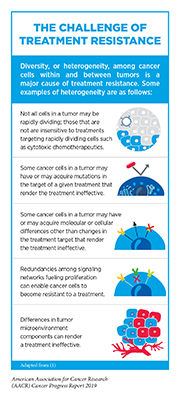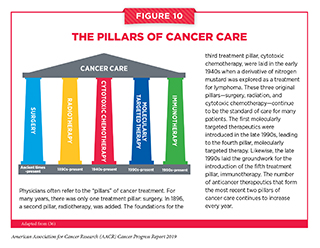Looking to the Future
In this section you will learn:
- Innovations in cancer research through interdisciplinary team science approaches will help shape the future of patient care.
- Integration and mining of health care data from various sources will allow researchers to gain more insights into cancer biology and thereby improve patient outcomes.
- Cutting-edge technologies that fuel the full spectrum of cancer science from bench to bedside will accelerate the pace at which we increase our understanding of cancer biology while transforming the future of clinical practice.
This is an exciting era of cancer research. Approval of novel therapeutics, coupled with an increasing public awareness of cancer prevention and early detection, has led to dramatic reductions in overall cancer mortality rates for all Americans. Recent discoveries in the fields of cancer genomics and immunology have firmly established two new pillars of cancer care – molecularly targeted therapy and immunotherapy – which are benefiting many patients with a wide range of cancer types.
These research fields also show immense promise for the future because the pace of progress in these areas is expected to accelerate in the coming years. However, to efficiently harness the information generated by cancer genomics and immunology research, it will be essential to engage scientists across disciplines who can translate these data into clinical benefit for more patients. According to AACR President, 2019 – 2020, Elaine R. Mardis, PhD, a convergence science approach, which merges traditional basic and clinical cancer research with applied mathematics, engineering, and physics, among other disciplines, will pave the way for the next breakthroughs in cancer science. The new wave of scientific and technological innovations driven by cross-disciplinary team science will have a transformative impact on patient care.
Technologies to Advance Cancer Science
Single Cell Technologies
Decades of research have led scientists to realize that tumors are a collection of highly heterogeneous cancer cells as well as other cell types. There is heterogeneity in genetic alterations between different cancer cells within a tumor as well as between primary and metastatic tumors. There is also cellular diversity within tumors, which comprise many different types of cells including immune cells and endothelial cells that make up blood vessels, in addition to cancer cells. Genetic heterogeneity within tumors contributes to treatment resistance and disease recurrence while interactions between cancer and immune cells within a tumor can influence response to treatments such as immunotherapy.
Past efforts at evaluating cellular and molecular characteristics of cancer used “bulk” analysis, which meant that multiple cell populations from the tumor mass or biopsy sample were profiled simultaneously. Although this approach provided many useful insights, it did not provide highly detailed information about the subtle differences between cells. Single cell technologies have ushered in a new era for medical research including cancer research. By using these techniques, researchers are able to quickly analyze molecular characteristics of single cells, and by combining data from hundreds or thousands of single cells from a tumor, they can obtain a better understanding of its heterogeneity (317).
There are many different single cell technologies, but their end-goal is the same: to help researchers understand the biological role of each type of cell in a tumor. For example, some researchers hope to differentiate the characteristics of cancer cells from immune cells, and to determine if the immune cells in the tumor are helping the cancer grow or are attacking it. Others are attempting to map the 3-dimensional location of cancer cells and other cell types within the tumor microenvironment by pairing single-cell technologies with the latest advanced imaging strategies (318). Spatial details extracted from such studies can be invaluable in understanding the interactions between cancer and other cells and the tumor microenvironment, which plays a key role in tumor growth and metastasis.
Gene Editing
Next-generation sequencing technologies have revolutionized the field of cancer genomics. As a result, we have identified numerous genetic alterations that are associated with cancer development. However, to confirm whether a genetic alteration can lead to cancer development, scientists need to determine the functional consequences of these genetic changes. Gene editing through CRISPR/Cas9 is a revolutionary approach that can help researchers add in a specific mutation of interest, and then study the functional outcomes of the mutation and its impact on biology (319). These methods provide a fast, precise, scalable, and efficient approach to gene editing compared with previous technologies. The development of CRISPR technology resulted from basic research into the immune system mechanisms of certain species of bacteria (320). CRISPR technology is being currently used by researchers throughout the medical research community in numerous ways. One area of extensive investigation is to identify safe and effective ways to use CRISPR-mediated gene editing for cancer immunotherapy with CAR T cells (321).
Technologies to Advance Patient Care
The new therapeutic and diagnostic technologies that are moving rapidly from the bench to the bedside have the potential to fundamentally change cancer care in the future.
Liquid Biopsies
A biopsy is the removal of cells or tissues from a patient for testing to help physicians diagnose a condition such as cancer or monitor how it changes in response to treatment. Traditionally, biopsies are invasive procedures. However, research has shown that during cancer development and treatment, tumors routinely shed detectable cells, lipid-encapsulated sacs called exosomes, and free DNA into a patient’s blood or cerebrospinal fluid. Recent studies have also shown that it is possible to use a blood or another biofluid sample, or liquid biopsy, rather than a traditional tissue biopsy, to obtain material that can be analyzed to provide information about the molecular alterations associated with a patient’s cancer (322).
Multiple liquid biopsy approaches to improve cancer screening, early detection, and monitoring of treatment response are being developed and tested in clinical trials (see sidebar on Moving toward Minimally Invasive Testing). Some of these focus on analyzing blood samples for mutations in the DNA sequence or epigenetic changes associated with cancer, while others look more broadly at the patterns of fragmentation of the shredded cell-free DNA in the blood (323-325). Early clinical data indicate that liquid biopsies have the potential to transform early detection, interception, diagnosis, treatment, and surveillance of cancer by identifying markers of disease, therapeutic response, resistance, and recurrence (326-328).
Big Data
To achieve the full potential of cancer genomics research, the molecular characteristics of a patient’s cancer need to be considered along with other factors, such as the patient’s genome, epigenome, microbiome, metabolome, lifestyle, and environmental exposures, all of which are emerging as important influences on cancer initiation, development, and progression. Integrating and harnessing data that include patient history, results from diagnostic and genetic tests, treatment decisions, and measured and patient-reported outcomes from large numbers of cancer patients may help us answer many of cancer’s most elusive questions in real time. For example, physicians may be able to match existing FDA-approved molecularly targeted therapeutics to novel cancer types, as well as identify subgroups of patients who are most or least likely to benefit from aggressive therapies.
Several cancer organizations as well as multi-institutional teams have already launched a number of initiatives to catalyze data integration. A few examples of these cross-institutional projects are AACR Project Genomics, Evidence, Neoplasia, Information, Exchange (GENIE), ASCO CancerLinQ, BRCA Exchange, NCI Genomic Data Commons, and , Oncology Research Information Exchange Network (ORIEN) (329). Continued advances in technological innovations as well as regulatory policy initiatives will be critical to overcome current barriers to data sharing and create a framework for a global data ecosystem that will accelerate discoveries and benefit patient care.
Artificial Intelligence
As we accumulate large quantities of patient data, artificial intelligence (AI) approaches, such as machine learning, have the potential to help us analyze vast amounts of health care information to derive meaningful insights that we previously could not have realized (330). Machine learning is an application of AI that focuses on the development of computer programs that can access and learn from data, identify patterns, and make decisions without explicit human intervention.
The clinical applications of AI are vast. For example, some of the recent approaches in liquid biopsy rely on AI to detect cancer in the blood. Other examples of the use of AI in patient care include radiological imaging analysis and pathology testing results determination, both of which are critical in diagnosing cancer. Traditionally, the former involves a radiologist scanning images by visually searching for signs of cancer while pathology testing involves a pathologist viewing a slide on which there is a slice of the abnormal tissue under a conventional light microscope to determine the presence of cancerous cells. Current methods of analyzing scans and slides are time consuming and can sometimes miss signs of cancer (false negative) or detect cancers that turn out to be imaging artifacts (false positives). AI has the potential to streamline processes for radiological and pathological image interpretation allowing for faster decision-making for people with life-threatening diseases. The applications of AI in radiology and pathology are an area of extensive research (331-334). Continued research is needed, to determine the full clinical potential of AI along with appropriate regulatory approaches to ensure safety and efficacy of this novel technology.
The Future of Treatment Combinations
A potential application of big data and machine learning in advancing future cancer treatments will be in the identification of combinations of therapeutics to treat cancers. Although molecularly targeted therapeutics and immunotherapeutics have transformed the landscape of cancer care, only a small fraction of patients respond to these treatments and most tumors eventually develop resistance to these agents (see sidebar on The Challenge of Treatment Resistance). As a way of starting to address these challenges, the FDA has approved combinations of molecularly targeted therapeutics, such as encorafenib and binimetinib for treatment of melanoma or combination of a molecularly targeted therapy with immunotherapy, such as pembrolizumab and axitinib for the treatment of kidney cancer.
These so-called rational combinations of therapeutics are based on our understanding of cancer initiation, progression, resistance, and/or recurrence. Combination of therapeutics within and between various treatment modalities, such as immunotherapy, molecularly targeted therapy, and cutting-edge radiotherapy, is being tested in many clinical trials against a wide array of cancers. Given that the number of potential combinations of treatments is already immense and will increase dramatically as the number of cancer therapeutics rises in the future, continued research is needed to identify biomarkers and the best diagnostic tests to detect such biomarkers to help identify the most likely effective treatment combinations.
Digital Health Technologies
U.S. health care is on the brink of a new revolution with the infusion of novel software and hardware technologies, referred to as digital health technologies, that aim to advance care management and delivery. Digital health technologies promise to improve patient outcomes through enhanced data collection and information flow. While some of these tools such as electronic health records have already become a new standard for patient care, others are just being introduced into clinical research and practice. These include connected devices that enable remote health monitoring (Internet of Things), wearables and activity trackers, smartphone apps, electronic patient-reported outcomes, telehealth and telemedicine, and digital therapeutics, among others. Digital health technologies have the potential to impact the full spectrum of clinical cancer care, from prevention and screening to treatment management, posttreatment follow-up, and survivorship. Effective implementation of these technologies may reduce health care costs and workflow inefficiencies and improve overall health care value, patient outcomes, and quality of life (335-336).
One application of digital health has been effective collection and integration of patient-reported outcomes (PROs) into clinical care. PROs enable direct measurement of the experiences of patients with cancer that until recently have primarily been captured when patients fill out questionnaires to report symptoms (337). However, innovative methods to document PROs, captured through wearable devices or mobile apps on smartphones, are increasingly providing a critical new perspective in clinical research and patient-centered care. Detailed information about symptoms, treatment burden, quality of life, and other experiences, documented in real time, is anticipated to provide researchers and clinicians with a vast amount of previously untapped data that can be harnessed for patient benefit. For example, symptoms monitored in real time can alert health care professionals to problems that might require immediate attention leading to modifications in treatment or clinical trial designs. In fact, several recent clinical trials have demonstrated that remote monitoring via digital heath platforms can reduce symptoms and improve survival (272, 338). Ongoing efforts are investigating the value of digital health technologies in enhancing efficiency in clinical trials, reducing barriers that give rise to cancer health disparities, promoting healthy behavior among cancer survivors, and evaluating new models of care delivery, such as home-based cancer treatments, among other endeavors.
Ongoing Developments in Radiation Therapy
Radiation therapy represents one of the central pillars of cancer treatment (see Figure 10). It has vital roles in curative and palliative treatment of patients with many types of cancer. Numerous new approaches are currently being studied to further improve the effectiveness of radiotherapy. One of the most promising new approaches is “FLASH” radiotherapy (FLASH-RT) (339). FLASH-RT involves delivering an extremely high dose of radiation in a very short period of time (340). It requires powerful devices capable of producing a radiation flow rate that is a thousand times more intense than that of conventional radiotherapy. Traditionally, radiation is delivered at a dose rate of approximately 0.03 Gray per second while FLASH-RT uses an ultrahigh dose-rate of 300 Gray per second. Consequently, radiation is delivered into the tumor in less than 200 milliseconds, compared to several minutes with standard radiotherapy. According to preliminary reports, a major advantage of FLASH-RT is that healthy tissue seems to better withstand this new method of radiotherapy, while the tumor has the same level of sensitivity to FLASH-RT as to conventional radiation (341).
Researchers are experimenting with a range of different ideas using FLASH-RT. One area of interest is evaluating whether FLASH-RT might benefit pediatric patients with brain tumors; the idea being tested is whether it could be used to reduce side effects in patients with standard risks, to increase the dose in patients with the most aggressive tumors, and to treat the very youngest patients who are most vulnerable to the long-term risk of side effects. In parallel with efforts to evaluate FLASH-RT in clinical care, basic scientists are also trying to gain a better understanding of why healthy tissue has a higher tolerance to this form of radiation.


